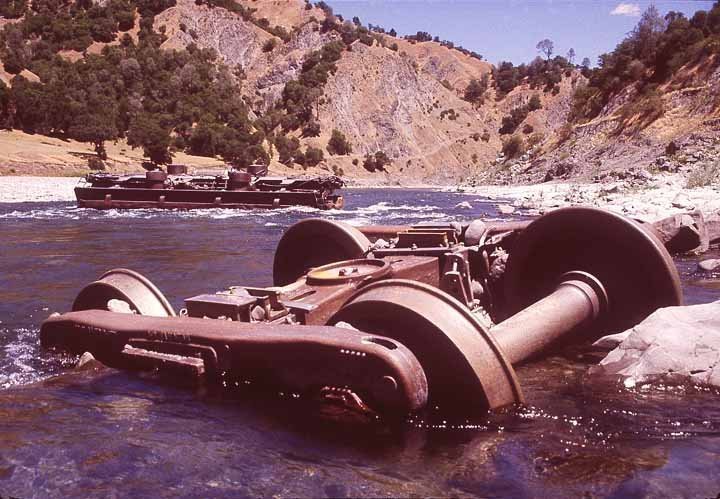
Photo: Friends of the Eel.
The North Coast Railroad Authority today signaled that it’s willing to railbank over 100 miles of dead tracks along the rugged Eel River — from Willits nearly to Scotia — so long as some other state agency pays the authority enough money to retire its debts.
At the same time, the authority says it hopes to someday open a Humboldt County-only railroad line from Scotia to Samoa, through Fortuna, Old Town Eureka and Arcata.
The moves come as the authority, a public agency, prepares to present a “strategic plan” to the California Transportation Commission at the end of January. In recent months, the commission has cast an increasingly wary eye on the struggling agency, calling for it to prepare a “shutdown plan” and asking the state legislature to form a special committee to hash out its future.
In response to this pressure, and in advance of the CTC meeting at the end of the month, NCRA Director John McCowen of Ukiah this morning presented his fellow board members with a draft “strategic plan” that he and the authority’s staff had prepared. (Read it here.) McCowen’s draft — as approved by the board on an 8-0 vote — officially foresakes the possibility of restoring rail service between Humboldt County and the Bay Area for the foreseeable future, and puts the possibility of railbanking a section of the NCRA’s main line on the table for the first time in the authority’s history.
“This is a momentous moment for the NCRA,” said Supervisor Estelle Fennell, one of Humboldt County’s two representatives on the NCRA board.
No trains have run in the geologically unstable Eel River Canyon for over 20 years. The draft strategic plan acknowledges that it would be immensely expensive to rebuild the track through the canyon, and that there is no compelling economic reason to try. But some other state agency might pay the authority to railbank that stretch of line so that the authority could retire some of its own debt:
[T]his scenic area is well suited for a multi-use trail, so long as it is understood that operation and maintenance issues will require dedicated funding to keep the right of way safe to users. Railbanking of this portion appears to be a viable option. State Parks or the Coastal Conservancy could purchase and manage this portion of the line for a multi-use trail under the federal railbanking process.
The authority has been strapped for cash for some time now, and is running large operational deficits. A great deal of its income comes from the sale and lease of public property that is under its control. At the same time, it has retained a Washington, D.C. legal firm to petition the U.S. Supreme Court hear its appeal of a California Supreme Court decision that held it to state environmental law.
As approved by the board of directors today, the NCRA’s new strategic plan will include the restoration of service between the Bay Area and Willits — currently, trains run only as far north as Windsor — and the institution of a brand-new Humboldt short line from Scotia to Humboldt Bay. It’s unclear from the strategic plan — which is only six-and-a-half pages long — exactly how much many of these projects would cost, or who would fund those costs, or what revenue they might be expected to reap.
If it ever does come to pass, though, it would mean that there would be two isolated railroad services operating on what was historically the Northwestern Pacific Railroad — one at the south end, and one at the north. The last major economic feasibility study commissioned by the NCRA, which dates from 2002, specifically decided that a line segmented in this fashion — which it labeled as “Scenario I” — would be a perpetual cash sink, no matter how much demand there was for its services:
The railroad has to operate the entire 300 miles in order to have a positive cash flow. Under Scenario I for all three demand categories, the railroad operated at a loss. The fixed costs of operating a railroad are too high to support the proposed 141-mile route between Willits and Schellville.
The North Coast Railroad Authority is scheduled to present its new strategic plan to the California Transportation Commission on Jan. 31 or Feb. 1.
###
DOCUMENT:
- Draft North Coast Railroad Authority “Strategic Plan.” Jan. 10, 2018.
- “The Long Term Financial and Economic Feasibility of the Northwestern Pacific Railroad,” PB Ports & Marine, Jan. 2003.
PREVIOUSLY:
- State Transportation Commission Raises Eyebrow at North Coast Railroad Authority Finances, Asks Perennially Beleaguered Agency to Prepare ‘Shutdown Plan’
- Government Railroad Agency Says It’s Still Looking to Bring Trains Back to Humboldt County, Even as its Finances and Fortunes Spiral Downward
- North Coast Railroad Authority, a State Agency, Will Ask U.S. Supreme Court to Rule That It is Not Bound By State Environmental Law
- RAILROAD NEWS: Citing ‘Uncertain Future,’ California Transportation Commission Calls for Special Committee to Hash Out What to Do With the North Coast Railroad Authority
CLICK TO MANAGE